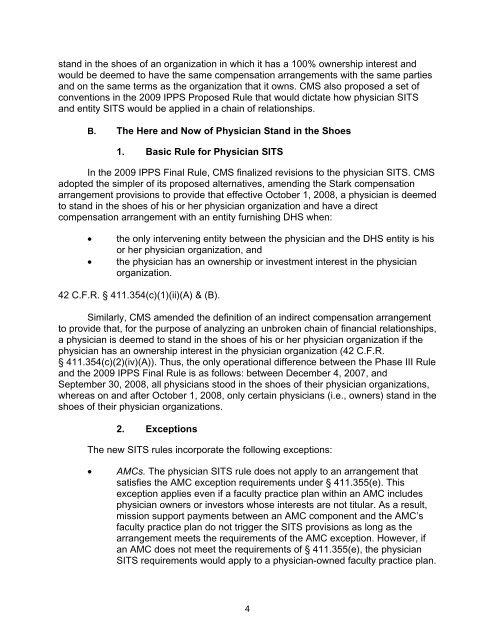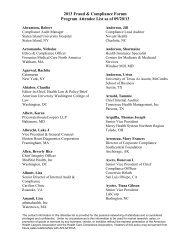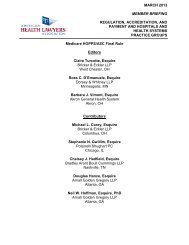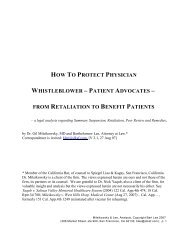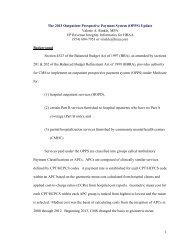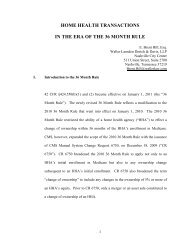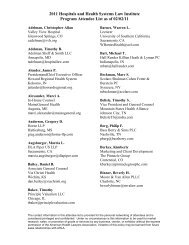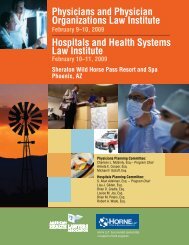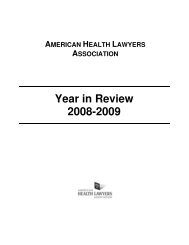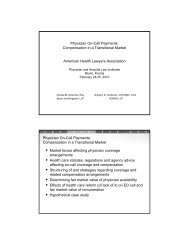The 2009 IPPS Final Rule - American Health Lawyers Association
The 2009 IPPS Final Rule - American Health Lawyers Association
The 2009 IPPS Final Rule - American Health Lawyers Association
You also want an ePaper? Increase the reach of your titles
YUMPU automatically turns print PDFs into web optimized ePapers that Google loves.
stand in the shoes of an organization in which it has a 100% ownership interest and<br />
would be deemed to have the same compensation arrangements with the same parties<br />
and on the same terms as the organization that it owns. CMS also proposed a set of<br />
conventions in the <strong>2009</strong> <strong>IPPS</strong> Proposed <strong>Rule</strong> that would dictate how physician SITS<br />
and entity SITS would be applied in a chain of relationships.<br />
B. <strong>The</strong> Here and Now of Physician Stand in the Shoes<br />
1. Basic <strong>Rule</strong> for Physician SITS<br />
In the <strong>2009</strong> <strong>IPPS</strong> <strong>Final</strong> <strong>Rule</strong>, CMS finalized revisions to the physician SITS. CMS<br />
adopted the simpler of its proposed alternatives, amending the Stark compensation<br />
arrangement provisions to provide that effective October 1, 2008, a physician is deemed<br />
to stand in the shoes of his or her physician organization and have a direct<br />
compensation arrangement with an entity furnishing DHS when:<br />
• the only intervening entity between the physician and the DHS entity is his<br />
or her physician organization, and<br />
• the physician has an ownership or investment interest in the physician<br />
organization.<br />
42 C.F.R. § 411.354(c)(1)(ii)(A) & (B).<br />
Similarly, CMS amended the definition of an indirect compensation arrangement<br />
to provide that, for the purpose of analyzing an unbroken chain of financial relationships,<br />
a physician is deemed to stand in the shoes of his or her physician organization if the<br />
physician has an ownership interest in the physician organization (42 C.F.R.<br />
§ 411.354(c)(2)(iv)(A)). Thus, the only operational difference between the Phase III <strong>Rule</strong><br />
and the <strong>2009</strong> <strong>IPPS</strong> <strong>Final</strong> <strong>Rule</strong> is as follows: between December 4, 2007, and<br />
September 30, 2008, all physicians stood in the shoes of their physician organizations,<br />
whereas on and after October 1, 2008, only certain physicians (i.e., owners) stand in the<br />
shoes of their physician organizations.<br />
2. Exceptions<br />
<strong>The</strong> new SITS rules incorporate the following exceptions:<br />
• AMCs. <strong>The</strong> physician SITS rule does not apply to an arrangement that<br />
satisfies the AMC exception requirements under § 411.355(e). This<br />
exception applies even if a faculty practice plan within an AMC includes<br />
physician owners or investors whose interests are not titular. As a result,<br />
mission support payments between an AMC component and the AMC’s<br />
faculty practice plan do not trigger the SITS provisions as long as the<br />
arrangement meets the requirements of the AMC exception. However, if<br />
an AMC does not meet the requirements of § 411.355(e), the physician<br />
SITS requirements would apply to a physician-owned faculty practice plan.<br />
4


